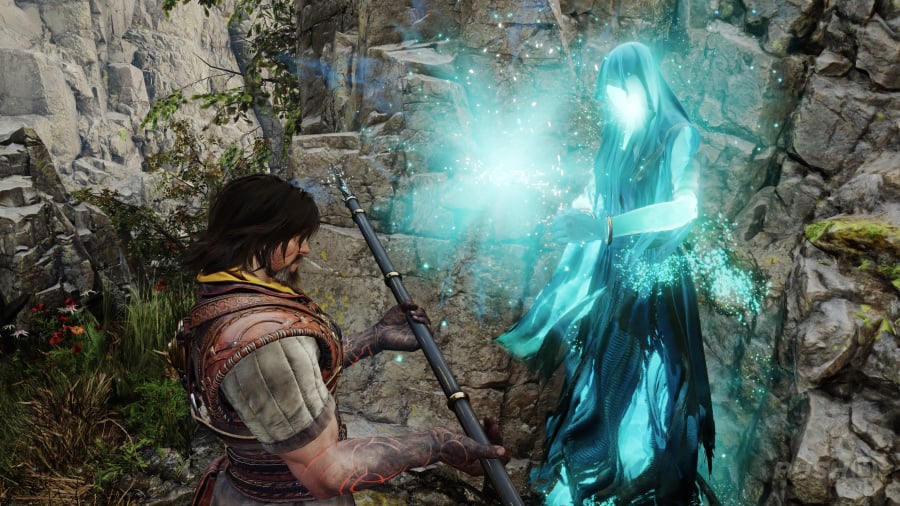
Blades of Fire is a dark fantasy action adventure game inspired by Santa Monica Studio’s modern God of War series and FromSoftware’s Souls series, and it’s a fairly compelling melding of the two. Central to its narrative and gameplay is the ability to forge a wide variety of powerful melee weapons, and gathering the materials required to do so forms its central gameplay loop.
Developed by MercurySteam, a Spanish development studio perhaps best known for 2010’s Castlevania: Lords of Shadow, Blades of Fire features solid combat and a vast world full of secrets and hidden pathways to explore. However, it is slightly let down by simplistic writing and a rather generic setting.
In ages past, mythical, technologically advanced giant beings known as The Forgers ruled over the world until a cataclysmic conflict wiped them out. As a last act, The Forgers created humans and entrusted to them the secret of The Steel, through the use of which mankind, in turn, came to dominate. Millenia later, Queen Nerea, a childhood friend of protagonist Aran de Lira, has cast a spell to turn the once mighty weapons of her enemies to stone, and rules as a tyrant.

During the game’s introduction, Aran acquires one of the legendary hammers of The Forgers, allowing him to take on the herculean task of putting a stop to Queen Nerea. The entire game is based around simply reaching the Royal Palace to defeat the Queen, and one of its greatest strengths is the sense of adventure it imparts as Aran, along with his young companion, Adso, are inevitably side-tracked and delayed in doing so.
Featuring a relatively high difficulty level on even the easiest setting (at least when it comes to boss encounters), combat is very much in the FromSoftware mould, with a few novel twists. For starters, each face button allows Aran to attack from either side, or aim blows at enemies’ heads or lower extremities. This system is complicated by certain enemies having various levels of resistance to damage (split between blunt, piercing, and slashing) on different parts of their body, or by only being vulnerable temporarily. There is also no levelling up; Aran’s health and stamina can only be improved by finding collectibles in the environment, a la Sekiro.

A massive variety of weapon types allows for implements that deal one or more types of damage, and switching between them mid-combat will often be crucial to success. Aran’s stamina bar will need to be appropriately managed to dodge and strike, but interestingly, blocking allows for rapid recovery. Weapons will degrade quickly with use, and can only be repaired so many times (determined by the forging process) before becoming useless. However, they can be recycled for common materials or offered to an NPC for rare components if one gains enough renown through slaying numerous foes.
The Forge is a mechanic and location where Aran can create new weapons, with schematics earned by defeating the enemies that carry them. It’s a cool concept, although the grinding required can sometimes be annoying, for example, needing to defeat a specific type of formidable foe 40 times to gain its particular sword variant. There’s a forging mini game that rewards fine craftsmanship with additional Forge Stars (the number of times a weapon can be repaired to max durability), and dimensions such as length and heft, along with the specific type of materials used, all make for a highly customisable, somewhat addictive crafting system.

Magical anvils scattered across the world allow access to The Forge and act as fast travel points, as well as places to rest and regain limited-use healing items. However, doing so will cause all non-boss enemies to respawn. It’s a familiar setup, complete with the undeniably satisfying unlocking of shortcuts to previous areas. Blades of Fire mixes things up by requiring various runes and keys to progress down specific pathways, with occasional backtracking required through earlier regions. The average player will need well over 60 hours to see Aran’s journey through; Blades of Fire’s vast game world is much larger than it might initially seem.
A mechanic we particularly enjoyed was Adso’s role in all this. Aran’s young companion, while occasionally annoying, adds some levity to the otherwise lonely game, and while a non-combatant, will take copious notes on the enemies and areas encountered. His compendium is filled out to various degrees, determined by the number of particular enemies Aran has defeated. This is represented by a lovingly illustrated in-game tome, written from Adso’s perspective, and compiles things like enemy types, statistics, weaknesses, and behaviours. He also lends a hand with environmental puzzles and can be called upon for additional regional information.

Blades of Fire looks and runs great on PS5 Pro, maintaining a consistently high frame rate even during battles against dozens of on-screen enemies. We found the art style and direction fairly generic, though, and the design of enemies was pretty lacklustre, with rare exceptions. Human enemies, in particular, reminded us of Gears of War without the characterisation: all bulging biceps, massive hands, and no necks to speak of.
Conclusion
Blades of Fire is a well-made and lengthy action adventure romp that will test your combat skills, provided you can see it through. Taking inspiration from some of gaming’s greatest hits, it never quite manages to reach those lofty heights itself, let down by a generic setting and lacklustre art direction. Still, it offers some interesting concepts, with combat and crafting mechanics that remain satisfying throughout.
